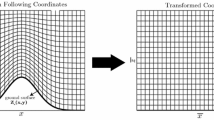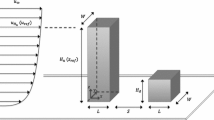Abstract
The large-eddy simulation (LES) and Reynolds-averaged Navier–Stokes (RANS) methodologies are used to simulate the air flow inside the container’s array geometry of the Mock Urban Setting Test (MUST) field experiment. Both tools are assessed and compared in a configuration for which the incident wind direction is perpendicular to the front array. The assessment is carried out against available wind-tunnel data. Effects of including small geometrical irregularities present in the experiments are analysed by considering LES and RANS calculations on two geometries: an idealized one with a perfect alignment and an identical shape of the containers, and a second one including the small irregularities considered in the experiment. These effects are assessed in terms of the local time-mean average and as well in terms of spatial average properties (relevant in atmospheric modelling) given for the velocity and turbulent fields. The structural flow properties obtained using LES and RANS are also compared. The inclusion of geometrical irregularities is found significant on the local time-mean flow properties, in particular the repeated flow patterns encountered in a perfect regular geometry is broken. LES and RANS provide close results for the local mean streamwise velocity profiles and shear-stress profiles, however the LES predictions are closer to the experimental values for the local vertical mean velocity. When considering the spatial average flow properties, the effects of geometrical irregularities are found insignificant and LES and RANS provide similar results.
Similar content being viewed by others
References
Bezpalcova K (2007) Physical modelling of flow and dispersion in an urban canopy. PhD thesis, Faculty of Mathematics and Physics, Charles University, Prague, 193 pp
Biltoft CA (2001) Customer report for Mock Urban Setting Test (MUST). DPG document WDTC-TP-01-028, West Desert Test Center, U.S. Army Dugway Porving Ground, Dugway, Utah, 58 pp
Cabot W, Moin P (1999) Approximate wall boundary conditions in the large eddy simulation of high Reynolds number flow. Flow Turbul Combust 63: 269–291
Camelli FE, Lohner R, Hanna SR (2005) VLES study of MUST experiment. In: 43rd AIAA Aerospace Meeting and Exhibit, January 10–13, Reno, Nevada, paper 1279, 19 pp
Castro IP, Apsley DD (1997) Flow and dispersion over topography: a comparison between numerical and laboratory data for two-dimensional flows. Atmos Environ 31: 839–850
Castro IP, Robins AG (1997) The flow around a surface-mounted cube in uniform and turbulent streams. J Fluid Mech 79: 307–335
Castro IP, Cheng H, Reynolds R (2006) Turbulence over urban-like roughness: deductions from wind-tunnel measurements. Boundary-Layer Meteorol 118: 109–131
Cheng H, Castro IP (2002) Near wall flow over urban-like roughness. Boundary-Layer Meteorol 104: 229–259
Cheng Y, Lien FS, Yee E, Sinclair R (2003) A comparison of large eddy simulations with a standard k–ɛ Reynolds-averaged Navier–Stokes model for the prediction of a fully developed turbulent flow over a matrix of cubes. J Wind Eng Ind Aerodyn 91: 1301–1328
Coceal O, Belcher SE (2004) A canopy model of mean winds through urban areas. Q J Roy Meteorol Soc 130: 1349–1372
Coceal O, Thomas TG, Castro IP, Belcher SE (2006) Mean flow and turbulence statistics over groups urban-like cubical obstacles. Boundary-Layer Meteorol 121: 491–519
Dejoan A, Santiago JL, Martilli A, Martin F, Pinelli A (2010) Comparison between large-eddy simulation and Reynolds-averaged Navier–Stokes computations for the MUST field experiment. Part II: effects of incident wind angle deviation on the mean flow and plume dispersion. Boundary-Layer Meteorol. doi:10.1007/s10546-010-9467-2
Di Sabatino S, Buccolieri, Olesen H, Ketzel M, Berkowicz R, Franke J, Schatzmann M, Schlünzen H, Leitl B, Britter R, Borrego C, Costa AM, Trini-Castelli S, Reisin T, Hellsten A, Saloranta J, Moussiopulos N, Barmpas F, Brzozowski K, Goricsan I, Balczò M, Bartzis J, Efthimiou G, Santiago JL, Martilli A, Piringer M, Hirtl M, Baklanov A, Nuterman R, Starchenko A (2009) COST 732: in practice: the MUST model evaluation exercise. Int J Environ Pollut (in press)
Dobre A, Arnold SJ, Smalley RJ, Boddy JWD, Barlow JF, Tomlin AS, Belcher SE (2005) Flow field measurements in the proximity of an urban intersection in London, UK. Atmos Environ 39: 4647–4657
Eichhorn J (2004) Application of a new evaluation guideline for microscale flow models. In: 9th international conference on harmonisation within atmospheric dispersion modelling for regulatory purposes, Garmisch-Partenkirchen, June 1–4, Germany, 5 pp
Flaherty JE, Stock D, Lamb B (2007) Computational fluid dynamic simulations of plume dispersion in urban Oklahoma City. J Appl Meteorol Clim 46: 2110–2126
Fluent Inc. (2005) FLUENT 6.2 User’s guide, vols 1–3. Fluent Inc., Lebanon, 2216 pp
Franke J, Bartzis J, Barmpas F, Berkowicz R, Brzozowski K, Buccolieri R, Carissimo B, Costa A, Di Sabatino S, Efthimiou G, Goricsan I, Hellsten A, Ketzel M, Leitl B, Nuterman R, Olesen H, Polreich E, Santiago JL, Tavares R (2008) The MUST model evaluation exercise: statistical analysis of modelling results. In: 12th international conference on harmonisation within atmospheric dispersion modelling for regulatory purposes, Cavtat, October 6–9, Croatia, 5 pp
Hanna SR, Tehranian S, Carissimo B, Macdonald RW, Lohner R (2002) Comparisons of model simulations with observations of mean flow and turbulence within simple obstacle arrays. Atmos Environ 36: 5067–5079
Kastner-Klein P, Plate EJ (1999) Wind-tunnel study of concentration fields in street canyons. Atmos Environ 33: 3973–3979
Kim JJ, Baik JJ (2004) A numerical study of effects of ambient wind direction on flow and dispersion in urban street canyons using the RNG k-ɛ turbulence model. Atmos Environ 38: 3039–3048
Launder BE, Spalding DB (1974) The numerical computation of turbulent flow. Comput Method Appl Mech Eng 3: 269–289
Leitl B, Bezpalcova K, Harms F (2007) Wind Tunnel Modelling Of The MUST Experiment. In: 11th international conference on harmonisation within atmospheric dispersion modelling for regulatory purposes, Cambridge, July 2–5, UK, 5 pp
Lim HC, Castro IP, Hoxey RP (2007) Bluff bodies in deep turbulent boundary layers: Reynolds-number issues. J Fluid Mech 571: 97–118
Martilli A, Santiago JL (2007) CFD simulation of airflow over a regular array of cubes. Part II: analysis of spatial average properties. Boundary-Layer Meteorol 122: 635–654
Martilli A, Clappier A, Rotach MW (2002) An urban surface exchange parameterization for mesoscale models. Boundary-Layer Meteorol 104: 261–304
Meinders ER, Hanjalic K (1999) Vortex structures and heat transfer in turbulent flow over a wall-mounted matrix of cubes. Int J Heat Fluid Flow 20: 255–267
Meroney RN, Pavegeau M, Rafailidis S, Schatzmann M (1996) Study of line source characteristics for 2D physical modelling of pollutant dispersion in street canyons. J Wind Eng Ind Aerodyn 62: 37–56
Michioka M, Sato A (2009) Numerical simulations of gas dispersion in a residential area. In: The seventh international conference on urban climate, Yokohama, June 29-July 3, Japan, 4 pp
Milliez M, Carissimo B (2007) Numerical simulations of pollutant dispersion in an idealized urban area for different meteorological conditions. Boundary-Layer Meteorol 122: 321–342
Nikitin NV, Nicoud F, Wasistho B, Squires KD, Spalart PR (2000) An approach to wall modelling in large eddy simulation. Phys Fluids 12: 1629–1632
Olesen HR, Baklanov A, Bartzis J, Barmpas F, Berkowicz R, Brzozowski K, Buccolieri R, Carissimo B, Costa A, Di Sabatino S, Efthimiou G, Franke J, Goricsan I, Hellsten A, Ketzel M, Leitl B, Nuterman R, Polreich E, Santiago J, Tavares R (2008) The MUST model evaluation exercise: patterns in model performance. In: 12th international conference on harmonisation within atmospheric dispersion modelling for regulatory purposes, Cavtat, October 6–9, Croatia, 5 pp
OpenFoam (2006) Version 1.3, User and Programmer guide. Technical Report. http://www.opencfd.co.uk/openfoam
Patankar SV (1980) Numerical heat transfer and fluid flow. Hemisphere Publishing Corporation, New York, 197 pp
Pavageau M, Schatzmann M (1999) Wind tunnel measurements of concentration fluctuations in an urban street canyon. Atmos Environ 33: 3961–3971
Piomelli U, Ballaras E (2002) Wall-layer models for Large Eddy Simulations. Annu Rev Fluid Mech 34: 349–374
Santiago JL, Martilli A, Martin F (2007) CFD simulation of airflow over a regular array of cubes. Part I: three-dimensional simulation of the flow and validation with wind-tunnel measurements. Boundary-Layer Meteorol 122: 609–634
Santiago JL, Coceal O, Martilli A, Belcher SE (2008) Variation of the sectional drag coefficient of a group of buildings with packing density. Boundary-Layer Meteorol 128: 445–457
Sini JF, Anquetin S, Mestayer PG (1996) Pollutant dispersion and thermal effects in urban street canyons. Atmos Environ 30: 2659–2677
Smagorinsky J (1963) General circulation experiments with the primitive equations. Mon Weather Rev 91(3): 99–164
Smorlakiewicz PK, Sharman R, Weil J, Perry SGc, Heist D, Bowker G (2007) Building resolving large-eddy simulations and comparison with wind tunnel experiments. J Comput Phys 227: 633–653
Snyder W (1981) Guidelines for fluid modelling of atmospheric dispersion. Report Number EPA-600/8-81-009, Environmental Protection Agency, Research Triangle Park, NC, 200 pp
Tseng Y-H, Meneveau C, Parlange M (2006) Modeling flow around bluff bodies and predicting urban dispersion using large eddy simulation. Environ Sci Technol 40: 2653–2662
VDI (2005) Environmental meteorology—prognostic microscale windfield models—evaluation for flow around buildings and obstacles. VDI guidelines 3783, Part 9, Beuth, Berlin
Versteeg HK, Malalasekera W (1995) An introduction to computational fluid dynamics. The finite volume method. Person Prentice Hall, Harlow, 272 pp
Xie Z, Castro IP (2006) LES and RANS for turbulent flow over arrays of wall-mounted obstacles. Flow Turbul Combust 76: 291–312
Xie Z, Castro IP (2009) Large-eddy simulation for flow and dispersion in urban streets. Atmos Environ 43: 2174–2185
Yakhot A, Anor T, Liu H, Nikitin N (2006) Direct numerical simulation of turbulent flow around a wall-mounted cube: spatio-temporal evolution of large-scale vortices. J Fluid Mech 566: 1–9
Yee E, Biltoft CA (2004) Concentration fluctuation measurements in a plume dispersing through a regular array of obstacles. Boundary-Layer Meteorol 111: 363–415
Yee E, Gailis RM, Hill A, Hilderman T, Kiel D (2006) Comparison of wind tunnel and water-channel simulations of plume dispersion through a large array of obstacles with a scales field experiment. Boundary-Layer Meteorol 121: 389–432
Author information
Authors and Affiliations
Corresponding author
Rights and permissions
About this article
Cite this article
Santiago, J.L., Dejoan, A., Martilli, A. et al. Comparison Between Large-Eddy Simulation and Reynolds-Averaged Navier–Stokes Computations for the MUST Field Experiment. Part I: Study of the Flow for an Incident Wind Directed Perpendicularly to the Front Array of Containers. Boundary-Layer Meteorol 135, 109–132 (2010). https://doi.org/10.1007/s10546-010-9466-3
Received:
Accepted:
Published:
Issue Date:
DOI: https://doi.org/10.1007/s10546-010-9466-3




